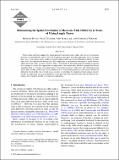| dc.contributor.author | Bates, Michael | |
| dc.contributor.author | Tulloch, Ross | |
| dc.contributor.author | Ferrari, Raffaele | |
| dc.contributor.author | Marshall, John C | |
| dc.date.accessioned | 2015-01-05T20:23:14Z | |
| dc.date.available | 2015-01-05T20:23:14Z | |
| dc.date.issued | 2014-06 | |
| dc.date.submitted | 2014-02 | |
| dc.identifier.issn | 0022-3670 | |
| dc.identifier.issn | 1520-0485 | |
| dc.identifier.uri | http://hdl.handle.net/1721.1/92705 | |
| dc.description.abstract | Observations and theory suggest that lateral mixing by mesoscale ocean eddies only reaches its maximum potential at steering levels, surfaces at which the propagation speed of eddies approaches that of the mean flow. Away from steering levels, mixing is strongly suppressed because the mixing length is smaller than the eddy scale, thus reducing the mixing rates. The suppression is particularly pronounced in strong currents where mesoscale eddies are most energetic. Here, a framework for parameterizing eddy mixing is explored that attempts to capture this suppression. An expression of the surface eddy diffusivity proposed by Ferrari and Nikurashin is evaluated using observations of eddy kinetic energy, eddy scale, and eddy propagation speed. The resulting global maps of eddy diffusivity have a broad correspondence with recent estimates of diffusivity based on the rate at which tracer contours are stretched by altimetric-derived surface currents. Finally, the expression for the eddy diffusivity is extrapolated in the vertical to infer the eddy-induced meridional heat transport and the overturning streamfunction. | en_US |
| dc.description.sponsorship | National Science Foundation (U.S.) (Grant 1233832) | en_US |
| dc.description.sponsorship | National Science Foundation (U.S.). Division of Polar Programs | en_US |
| dc.description.sponsorship | National Science Foundation (U.S.) (Modeling Ocean Variability and Biogeochemical Cycles Project) | en_US |
| dc.language.iso | en_US | |
| dc.publisher | American Meteorological Society | en_US |
| dc.relation.isversionof | http://dx.doi.org/10.1175/JPO-D-13-0130.1 | en_US |
| dc.rights | Article is made available in accordance with the publisher's policy and may be subject to US copyright law. Please refer to the publisher's site for terms of use. | en_US |
| dc.source | American Meteorological Society | en_US |
| dc.title | Rationalizing the Spatial Distribution of Mesoscale Eddy Diffusivity in Terms of Mixing Length Theory | en_US |
| dc.type | Article | en_US |
| dc.identifier.citation | Bates, Michael, Ross Tulloch, John Marshall, and Raffaele Ferrari. “Rationalizing the Spatial Distribution of Mesoscale Eddy Diffusivity in Terms of Mixing Length Theory.” J. Phys. Oceanogr. 44, no. 6 (June 2014): 1523–1540. © 2014 American Meteorological Society | en_US |
| dc.contributor.department | Massachusetts Institute of Technology. Department of Earth, Atmospheric, and Planetary Sciences | en_US |
| dc.contributor.mitauthor | Marshall, John C. | en_US |
| dc.contributor.mitauthor | Bates, Michael | en_US |
| dc.contributor.mitauthor | Tulloch, Ross | en_US |
| dc.contributor.mitauthor | Ferrari, Raffaele | en_US |
| dc.relation.journal | Journal of Physical Oceanography | en_US |
| dc.eprint.version | Final published version | en_US |
| dc.type.uri | http://purl.org/eprint/type/JournalArticle | en_US |
| eprint.status | http://purl.org/eprint/status/PeerReviewed | en_US |
| dspace.orderedauthors | Bates, Michael; Tulloch, Ross; Marshall, John; Ferrari, Raffaele | en_US |
| dc.identifier.orcid | https://orcid.org/0000-0002-3736-1956 | |
| dc.identifier.orcid | https://orcid.org/0000-0001-9230-3591 | |
| dc.identifier.orcid | https://orcid.org/0000-0002-3729-1417 | |
| mit.license | PUBLISHER_POLICY | en_US |
| mit.metadata.status | Complete | |
